Flagship IEM Shootout: 64 Audio U12t, qdc Anole VX, Sony IER-Z1R, Vision Ears VE8
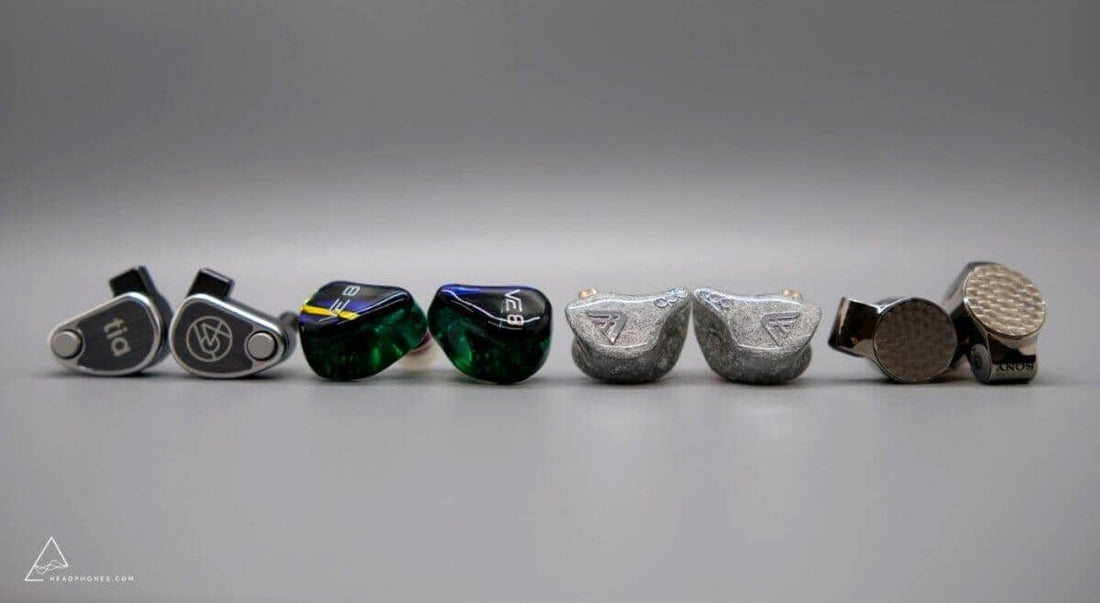
Preface
The 64 Audio U12t ($2000). The Sony IER-Z1R ($1700). The qdc Anole VX ($2300). The Vision Ears VE8 ($2200). If you’ve ever checked out the world’s largest IEM ranking list, then you’ll know what these IEMs are: they’re IEM reviewer Crinacle’s S-ranked IEMs. Out of a mind-boggling 800+ IEMs that the man has heard, these are the four IEMs - the top 0.05%, the cream of the crop - that have been awarded the prestigious “S” grade. As a newcomer to the hobby, I still remember staring at these IEMs on his ranking list with stars in my eyes and, simultaneously, with a sense of detachment at knowing I’d probably never hear much less own one of them.
...well, stuff happened. A lot. And since then, I’ve heard all four IEMs (and all the “S-” IEMs on Crinacle’s ranking list for that matter). Some of them were heard at different points in time, all were heard for varying degrees of time, and none were heard all at the same time. But thanks to a very generous reader, I’ve had the unprecedented opportunity to evaluate all four of these IEMs against each other from the comfort of my home for the last couple months. Now I’ll finally be sharing my thoughts on how they stack up against one another. Consider a tribute, if you will, to the world’s most comprehensive IEM ranking list and to some of the few IEMs to have blown me away.
These units were provided for review by a generous reader. At the end of the review period, they will be returned and, as always, what follows are my honest thoughts and opinions to the best of my ability.
Rankings will be denoted with a (x) and with the lowest number being the best.
The Tangibles



The IER-Z1R also has the build that inspires the most confidence out of its peers. From it’s perlage finished faceplates to its robust zirconium build, it simply makes you think “Damn, I got my money’s worth” when its in your hands.
In second place, we have the (2) Vision Ears VE8. The VE8 arrives in simple packaging that pales relative to the IER-Z1R, but the unboxing experience is solid and commensurate with what one would expect of a flagship IEM. You have a hockey-puck style case (with a rubber inlining, nice!), an assortment of SpinFit tips, a cleaning tool and cloth, and a bottle of cleaning liquid. I’d say the included cable is one step ahead of the 64 Audio cable; that is to say, barely acceptable. The VE8’s build is also just your standard acrylic shell affair, nothing much else to say on that front. Did I mention that the packaging for this one smells really nice, though?


On the other hand, the (3) 64 Audio U12t continues to be a shoo-in for one of the weakest unboxing games that I’ve seen at the flagship level. The revised packaging includes their pleather hockey-puck case, an assortment of SpinFit tips, and the MX/M15/M20 Apex modules. The included cable with memory wire has not changed as far as I can tell, unfortunately. Credit where credit is due, these accessories are better than the affronts to usability from not too long ago, but that’s not a high bar.

(no photos of the stock cable here because it'd burn readers' eyes)
The U12t’s body is milled out of solid aluminum. The faceplate, however, can be susceptible to being dented from photos that I’ve seen of other U12ts. I would also like to have seen recessed 2-pin connectors being used, as it is a frequent stress point of the IEM.
To my surprise, the (3) qdc Anole VX’s unboxing doesn’t fare much better; if anything, it might even be worse than the U12t. The only difference, really, is that the included cable isn’t nearly as bad as the U12t’s or the VE8’s. I’m not really a fan of the VX’s case. It requires you to wrap the cable around a peg to fit the IEMs which, in reality, is just time consuming and doesn’t have much practical value.


The Anole VX definitely stands out for its build quality, though. It uses qdc 2-pin connectors, which is significantly more robust than standard flush connectors. The switch system is also implemented cleanly even if it really just means more moving parts for failure.
Fit and Comfort
It probably goes without saying, but fit and comfort are 100% subjective and unique to your ear anatomy. This is just a reflection of how these IEMs stack up for me in this category.
(1) There’s only a few IEMs that I’ll wear for 5+ hours, and the U12t is one of them. The simplicity of the teardrop housing works perfectly for my ears, and once you stack on 64A’s Apex pressure-relief technology, there’s just no contest.

(2) Both the Anole VX and VE8 sport standard builds that more readily conform to the ergonomics of the ear. I do find both to be a tad tight; however, my ears will get through a couple hours of listening without too much trouble.


(3) The IEM with no doubt the most contentious fit is the IER-Z1R. And it’s not hard to see why. The housing of the IER-Z1R is absolutely massive in order to accommodate its large bass driver; consequently, nothing about it remotely conforms to the ergonomics of the average human ear. I started out only being able to listen to the IER-Z1R for half an hour at a time and slowly have managed to get that number up to a little over an hour.
(Again, no photos here because it's that ugly. ...okay - fine - maybe I just forgot to take the photos).
Tonal Analysis
(1) 64 Audio U12t
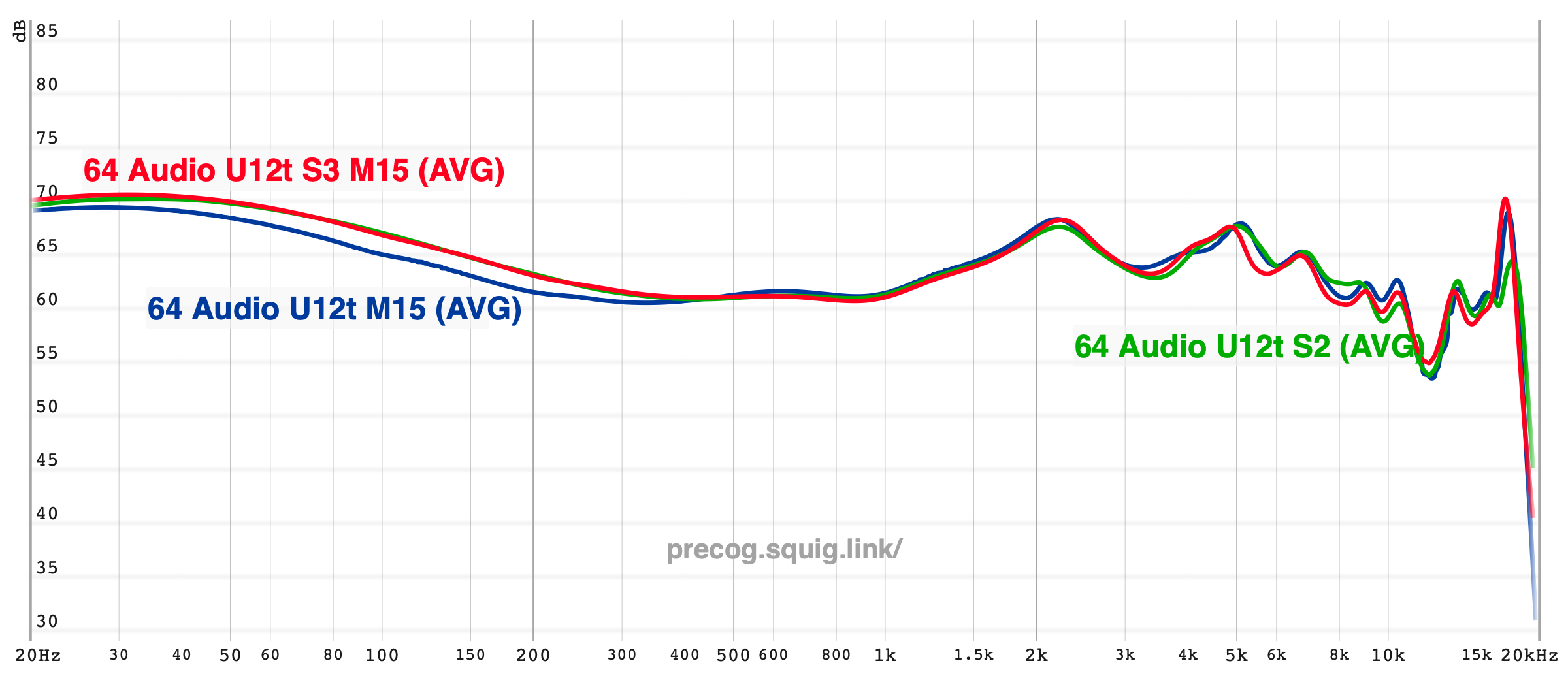
The U12t sports a slick, U-shaped presentation with a touch of spice up-top in the treble. Something that surprises a lot of listeners is how bassy the U12t is, but it’s controlled bass and some of the best BA bass you’ll find. The midrange takes a backseat with female vocals, aptly killing any sibilance and striking a dead-balanced note weight. Some, however, might find the U12t to sound somewhat suppressed and to lack bite in those upper-registers. Treble is the most unique part of the U12t’s sound, and what you hear will depend on the limits of your hearing. For me, it’s about equal parts lower-treble and air with copious amounts of shimmer. For others who’s hearing doesn’t token the ~15kHz spike, the U12t will likely sound more dark due to its dip after 10kHz or so.
You’re probably wondering what those Apex modules do. As the number of the module goes up, so does the quantity of bass. In turn, this has psychoacoustic effects on perception of the treble and staging; the MX/M15 modules will give you a brighter treble response and more open staging at the expense of some “oomph” in your bass. The modules are mainly personal preference, and you’ll have to figure out which works best for you.
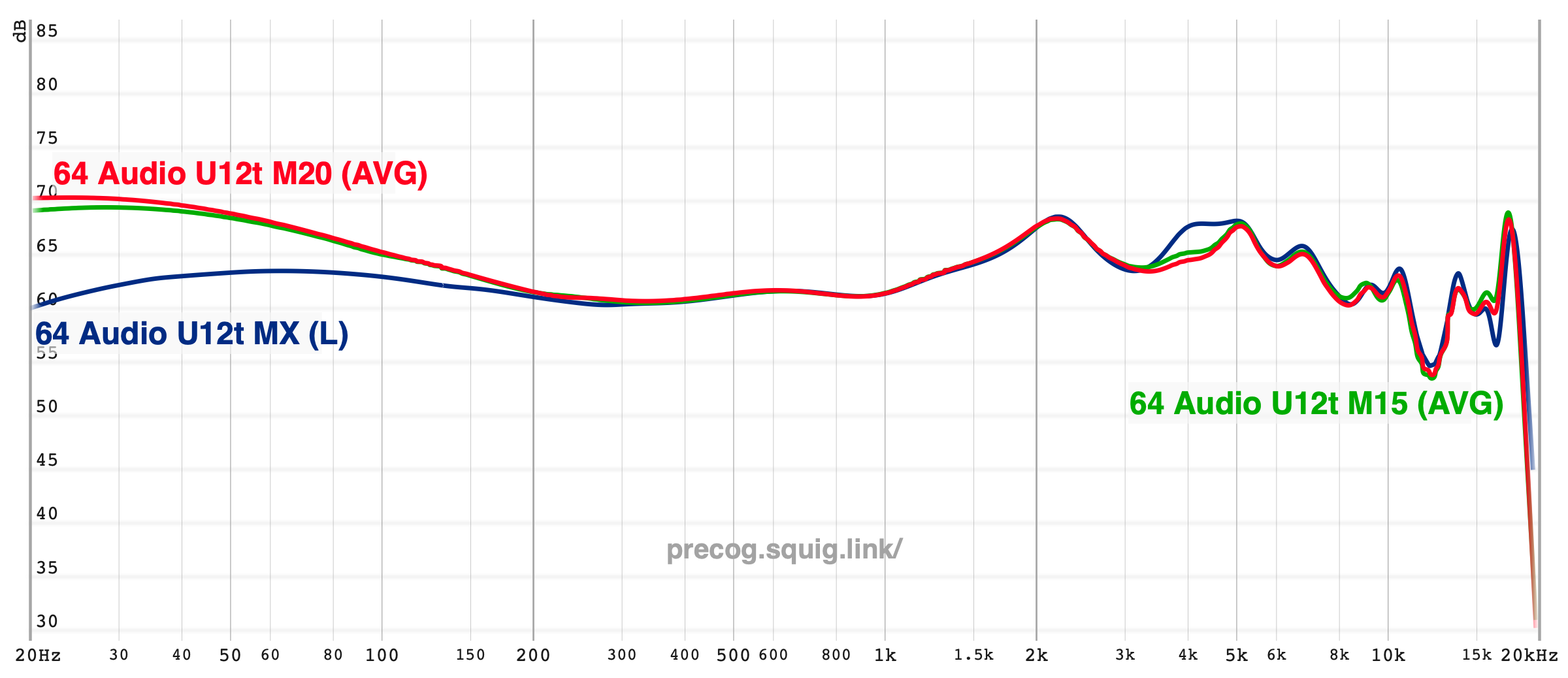
- Laidback, U-shaped frequency response.
- Excellent BA bass, even better than most DDs I’ve heard.
- Recessed, relaxed midrange presentation at the expense of being devoid of sibilance.
- Not for everyone in the treble response.
(2) Sony IER-Z1R
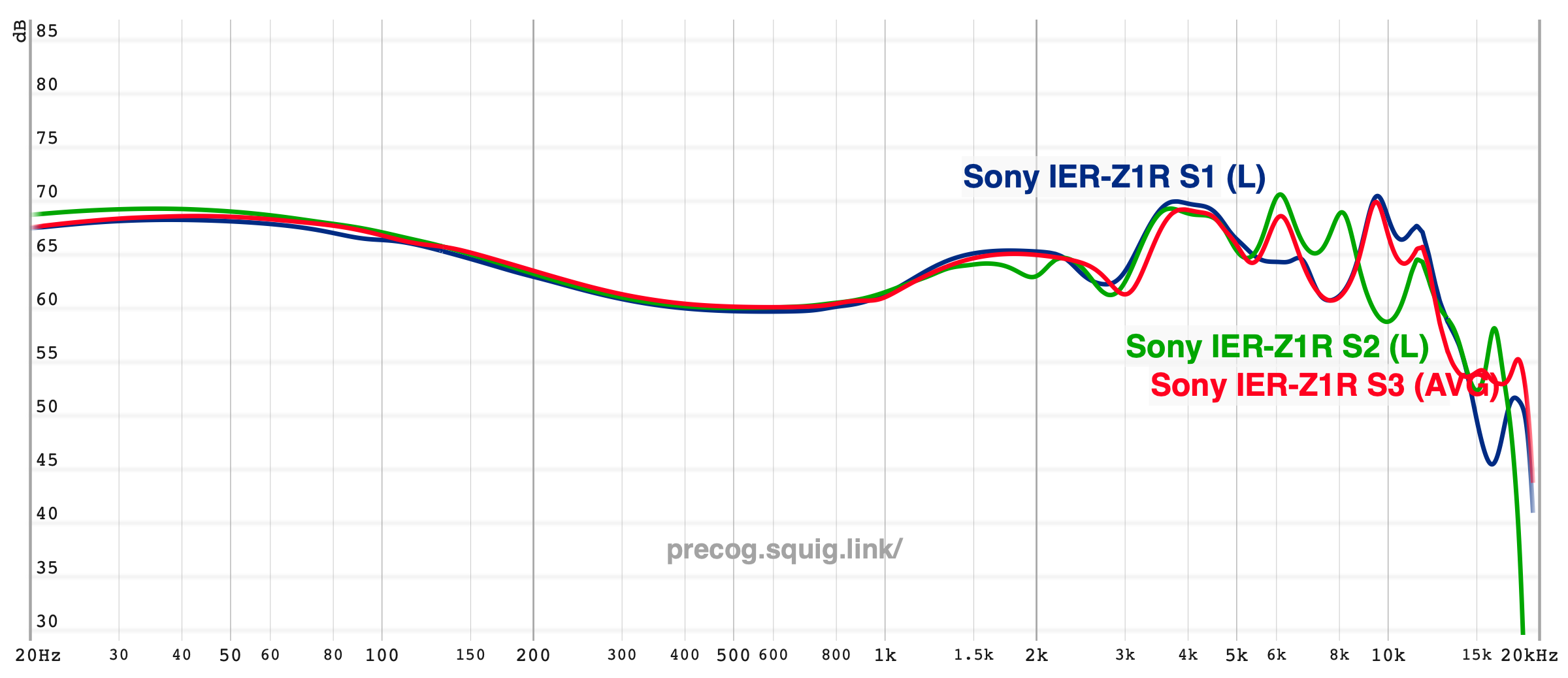
It’s no secret that this is one of the more unbalanced flagship IEMs on the market. The bass shelf on the IER-Z1R is largely concentrated to the sub-bass regions. It is some of the best bass in portable audio with unprecedented robustness and control, only really falling short in the dynamics department (it doesn't sound as fluid as it should). The bass is followed by a near ruler-flat lower-midrange; then comes many listeners' point of contention: the IER-Z1R’s upper-midrange. The upper-midrange is…forward, mostly, but it exhibits an egregious recession at around 2.5kHz, right in the middle of its pinna gain. Female vocals exist in a limbo of forward and slightly sucked out. Treble on the IER-Z1R might also prove polarizing for some listeners. It’s lower-treble oriented with a strong bump at 6kHz which lends to tremendous amounts of leading impact to percussive hits. The sheer robustness of the IER-Z1R’s treble cannot be understated; however, some listeners might find it fatiguing. Extension, at least, is superb, and with a beautiful sense of trailing reverb.
Highlights:
- Not a very balanced sound signature (something of a mild-V shape).
- Competition’s slowly caught up, but still some of the best bass in portable audio.
- Polarizing midrange (correction: the midrange sucks in my opinion).
- Polarizing treble pending the fit you achieve with the IER-Z1R, but I think it’s awesome.
(3) qdc Anole VX
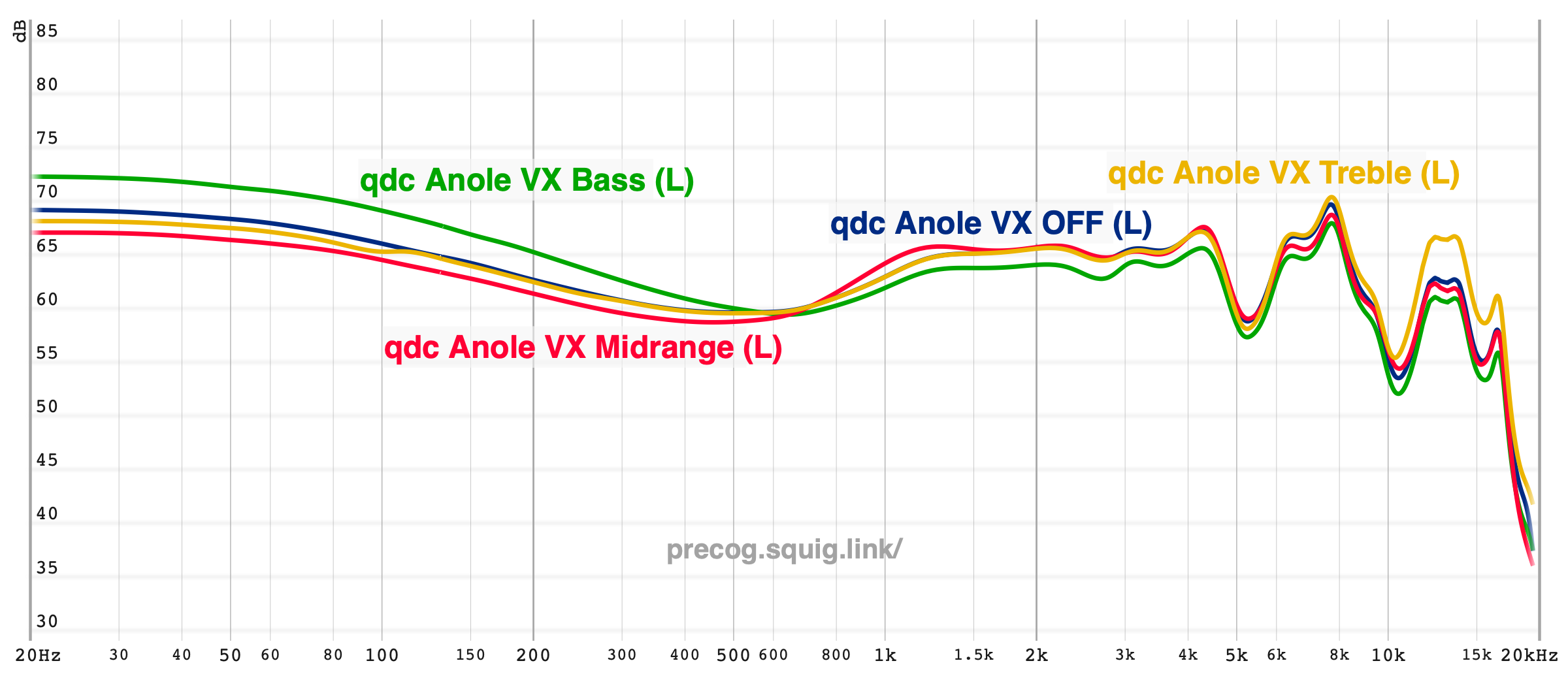
The “tuned by a committee and it shows” IEM of this shootout. But is that such a bad thing? I don’t necessarily think so. The VX has a balanced, but not necessarily neutral sound. It has a clean sub-bass shelf, followed by a slight upper-midrange boost that skews note-weight slightly thin. Something pretty distinctive about the qdc sound is a strong recession at 5kHz. At the expense of some snap to percussive impact, this effectively kills any sibilance and keeps the treble from being fatiguing. Well, that’s what I’d like to say. But in reality, the VX also exhibits generous amounts of mid-treble at 7kHz that lends to a brighter presentation in tandem with the upper-midrange boost.
You can play around with the switches to better suit the VX to your tastes, but I’d really just stick with the stock configuration. The bass switch bloats the VX’s bass quite a lot and just makes it sound overly plasticky. The midrange switch actually lowers the bass, instead, to lend to the perception of the midrange sounding more forward. Finally, the treble switch - yeah, you probably know what I’m going to say because I already don’t like the VX’s stock treble: just leave that off.
Highlights:
- Sounds like it was tuned by a committee, and that’s because it probably was.
- Balanced, but not neutral sound signature.
- Treble can be fatiguing despite qdc’s attempts to neuter potential sibilance.
- Decent bass for a BA, but nothing really special.
(4) Vision Ears VE8

The VE8 is tuned to what I would characterize as the epitome of Western tuning. It is a warm, counter-clockwise tilted sound, and those who have heard the VE8 will know that there’s one aspect which this IEM knows no peer in: male vocals. Indeed, anything that tokens the lower frequency bands seems to have just the right amount of texture and crunch to it, lending to what most would describe as a soulful, emotional presentation. It’s far from being a perfect midrange presentation, though, and I’m one of the rare listeners that hears sibilance with the VE8 due to its peak at 6kHz. The “s” consonance, in particular, has a grating characteristic that often pulls me out of my reverie whilst admiring this IEM’s midrange.
The other weak point of the VE8’s tuning is no doubt it’s treble response. It is largely mid-treble oriented - fine - but it really struggles with extension over 10kHz. It’s just not a particularly airy IEM, especially for one that many would deem worthy of “best in the world” status. Intentional by Vision Ears or not - it does lend their IEMs to a warmer listen, after all - I cannot back this tuning decision. The VE8’s treble is consequently quite dull, and it lends to an overly saturated presentation to my ears.
Highlights:
- Warm-neutral sound signature.
- Typical BA bass.
- Thick midrange that plays best with male vocals, but there’s traces of sibilance.
- Rolled-off treble that is not nearly commensurate with “best in the world” status.
Technical Performance
(1) 64 Audio U12t
The U12t gets some flack for being clinical and overly bland, but I will tell you this right now: It is the most dynamic of these four IEMs. For a sense of scaling gradations in loudness and articulating them with a good sense of weight, there are few IEMs that can play ball with the U12t. The detail on the U12t also comfortably plays at the top, and it has world-class layering and imaging. Indeed, in terms of imaging, it is one of the few IEMs that I have heard with some semblance of soundstage depth, even if it decidedly falls short in the soundstage height department.
That said, note definition is not the U12t’s strongest suit. It skews only slightly quicker than the IER-Z1R in terms of transient speed. Hundreds of hours of listening also suggests there might be a minor sense of disjointedness between the bass and midrange frequencies versus the treble. The tia driver seems to attack slightly sharper in the treble than the ancillary, lower frequencies. This mostly ends up working, though, because the large amounts of reverb and shimmer to the treble matches the slightly slower decay of the lower-frequencies. This slower sense of decay likely contributes to the U12t’s unexpectedly pleasant timbre for a BA monitor.

(2) qdc Anole VX
I don’t need to listen long to know that this is a very technical IEM. Notes are sharp - almost unnaturally sharp - on the VX, and enough to give me a headache whenever I swap over from something more timbrally pleasing. I also find the detail on the VX to be somewhat artificial; to some extent, the product of its tonality. Nonetheless, there are few IEMs on the planet that compete with the VX in the macro-detail department and it takes the cake here between these four IEMs. The imaging of the VX is slightly above average, but by no means holographic.
Unfortunately, if you’re looking for dynamics, the VX doesn’t really have any. It’s a very flat sounding monitor, and while it has decent micro-detail, it’s micro-dynamics are as flat as its dynamic range as a whole. Music sounds overly loud on the VX and I find myself opting to listen at quieter volumes in tandem with its plasticky timbre. Another criticism I have about the VX is its imaging. The way it fleshes out the center image is unsatisfactory, and I frequently find myself crossing my eyes and looking inwards, somewhere inside my head, to discern the center image. It follows, of course, that the VX has no soundstage depth to my ears.

(3) Sony IER-Z1R
The IER-Z1R’s intangible calling card is unquestionably its imaging. It has the unprecedented ability to shape the walls of the stage, resulting in the closest I’ve heard to a speaker-like presentation among IEMs. There’s really nothing quite like it, and at the expense of sounding like a dirty shill, it simply makes you feel like a king. Note definition is also fairly sharp due to the tuning tricks that Sony has played with the IER-Z1R’s tuning.
Where the IER-Z1R mostly meets the short end of the stick is in coherency. This is the bane of every hybrid, and the IER-Z1R is no exception. The attack and decay of its frequency bands don’t match very closely, particularly in the midrange. The IER-Z1R’s midrange is more downwards-sloping to the way it attacks, and it decays with more grit than the dynamic drivers being used to token the bass and treble frequencies. There’s also the fact that the IER-Z1R’s really not all that detailed. It has good surface-level detail due to its tuning, but for a general sense of detail, I do feel that the qdc Anole VX and 64 Audio U12t edge it out.

(4) Vision Ears VE8
The VE8 is interesting, and admittedly, I’ve struggled a lot with assessing its technical competency. It noticeably has a decent amount of blunting to the way it attacks; therefore, it is not a strong performer for note definition. And really, that’s just what happens when you have a tuning this warm and rolled-off in the treble. Not helping matters even further is that the VE8’s staging distribution is nothing more than average to my ears; notes come from close to the head and don’t spread out much further.
All that said, I can’t knock the feeling that it does have decent detail and a good sense of capturing smaller nuances in music. It’s just been obscured - heavily - by the VE8’s tuning, so it more closely presents itself as a sense of micro-dynamics. As for whether the VE8’s worthy of “best in the world” level detail, though, I’m inclined to say no. Likewise, timbre on the VE8 is quite pleasant for a BA monitor, but it’s still a way off best-in-class due to a noticeable amount of “grit” to the way notes decay.

Which One is For You?
Ultimately, while I can break down which IEM is “better” for each subset of sound quality all day, the one that suits you best will largely come down to subjective preference. Let me quickly water it down some more.
If you’re looking for the most “fun” of these IEMs, the one with the most special sauce, then you’ll want the IER-Z1R. But hold up. Demo it first. The fit is highly contentious, and it will make or break your enjoyment with these IEMs. If you can’t live without your midrange, then you’ll also want to give the IER-Z1R a pass.
The IEM that I would recommend to listeners who have no idea of what they want is the U12t. On paper, it is (in my humble opinion) the “best” IEM on the market today. On the other hand, it’s the definition of the kid in school who gets a 90% in every subject, but can’t seem to get 100% in anything. Once you’ve figured out your preferences, a lot of people are happy to move on. Ultimately, a lot of people will say they “respect” the U12t but that it doesn’t necessarily engage them as much as some other IEMs do.
The VX is probably the IEM that will impress most listeners right out the gate, but that quickly gets old. Fun fact: Pretty much everyone I know who has owned a VX has
